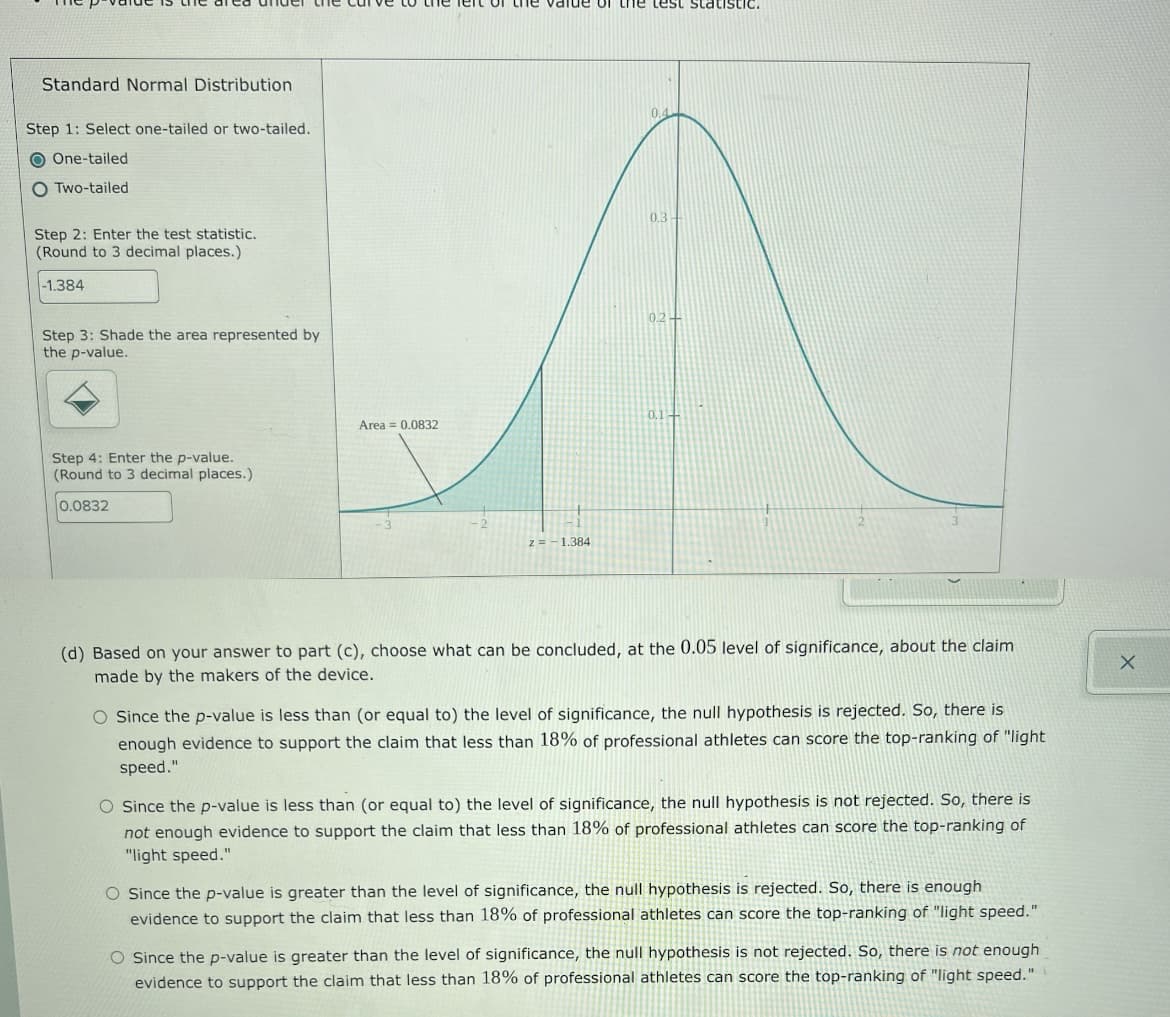Standard Normal Distribution 0.4 Step 1: Select one-tailed or two-tailed. O One-tailed O Two-tailed 0.3 Step 2: Enter the test statistic. (Round to 3 decimal places.) -1.384 0.24 Step 3: Shade the area represented by the p-value. Area = 0,0832 Step 4: Enter the p-value. (Round to 3 decimal places.) 0.0832 Z =-1.384 (d) Based on your answer to part (c), choose what can be concluded, at the 0.05 level of significance, about the claim made by the makers of the device. O Since the p-value is less than (or equal to) the level of significance, the null hypothesis is rejected. So, there is enough evidence to support the claim that less than 18% of professional athletes can score the top-ranking of "light speed." O Since the p-value is less than (or equal to) the level of significance, the null hypothesis is not rejected. So, there is not enough evidence to support the claim that less than 18% of professional athletes can score the top-ranking of "light speed." O Since the p-value is greater than the level of significance, the null hypothesis is rejected. So, there is enough evidence to support the claim that less than 18% of professional athletes can score the top-ranking of "light speed." O Since the p-value is greater than the level of significance, the null hypothesis is not rejected. So, there is not enough evidence to support the claim that less than 18% of professional athletes can score the top-ranking of "light speed."
Standard Normal Distribution 0.4 Step 1: Select one-tailed or two-tailed. O One-tailed O Two-tailed 0.3 Step 2: Enter the test statistic. (Round to 3 decimal places.) -1.384 0.24 Step 3: Shade the area represented by the p-value. Area = 0,0832 Step 4: Enter the p-value. (Round to 3 decimal places.) 0.0832 Z =-1.384 (d) Based on your answer to part (c), choose what can be concluded, at the 0.05 level of significance, about the claim made by the makers of the device. O Since the p-value is less than (or equal to) the level of significance, the null hypothesis is rejected. So, there is enough evidence to support the claim that less than 18% of professional athletes can score the top-ranking of "light speed." O Since the p-value is less than (or equal to) the level of significance, the null hypothesis is not rejected. So, there is not enough evidence to support the claim that less than 18% of professional athletes can score the top-ranking of "light speed." O Since the p-value is greater than the level of significance, the null hypothesis is rejected. So, there is enough evidence to support the claim that less than 18% of professional athletes can score the top-ranking of "light speed." O Since the p-value is greater than the level of significance, the null hypothesis is not rejected. So, there is not enough evidence to support the claim that less than 18% of professional athletes can score the top-ranking of "light speed."
MATLAB: An Introduction with Applications
6th Edition
ISBN:9781119256830
Author:Amos Gilat
Publisher:Amos Gilat
Chapter1: Starting With Matlab
Section: Chapter Questions
Problem 1P
Related questions
Question

Transcribed Image Text:de or th1e test statistic.
Standard Normal Distribution
0.4
Step 1: Select one-tailed or two-tailed.
O One-tailed
O Two-tailed
0.3
Step 2: Enter the test statistic.
(Round to 3 decimal places.)
-1.384
0.24
Step 3: Shade the area represented by
the p-value.
0.1-
Area = 0.0832
Step 4: Enter the p-value.
(Round to 3 decimal places.)
0.0832
z=- 1.384
(d) Based on your answer to part (c), choose what can be concluded, at the 0.05 level of significance, about the claim
made by the makers of the device.
O Since the p-value is less than (or equal to) the level of significance, the null hypothesis is rejected. So, there is
enough evidence to support the claim that less than 18% of professional athletes can score the top-ranking of "light
speed."
O Since the p-value is less than (or equal to) the level of significance, the null hypothesis is not rejected. So, there is
not enough evidence to support the claim that less than 18% of professional athletes can score the top-ranking of
"light speed."
O Since the p-value is greater than the level of significance, the null hypothesis is rejected. So, there is enough
evidence to support the claim that less than 18% of professional athletes can score the top-ranking of "light speed."
O Since the p-value is greater than the level of significance, the null hypothesis is not rejected. So, there is not enough
evidence to support the claim that less than 18% of professional athletes can score the top-ranking of "light speed."
Expert Solution
This question has been solved!
Explore an expertly crafted, step-by-step solution for a thorough understanding of key concepts.
Step by step
Solved in 2 steps

Recommended textbooks for you

MATLAB: An Introduction with Applications
Statistics
ISBN:
9781119256830
Author:
Amos Gilat
Publisher:
John Wiley & Sons Inc

Probability and Statistics for Engineering and th…
Statistics
ISBN:
9781305251809
Author:
Jay L. Devore
Publisher:
Cengage Learning

Statistics for The Behavioral Sciences (MindTap C…
Statistics
ISBN:
9781305504912
Author:
Frederick J Gravetter, Larry B. Wallnau
Publisher:
Cengage Learning

MATLAB: An Introduction with Applications
Statistics
ISBN:
9781119256830
Author:
Amos Gilat
Publisher:
John Wiley & Sons Inc

Probability and Statistics for Engineering and th…
Statistics
ISBN:
9781305251809
Author:
Jay L. Devore
Publisher:
Cengage Learning

Statistics for The Behavioral Sciences (MindTap C…
Statistics
ISBN:
9781305504912
Author:
Frederick J Gravetter, Larry B. Wallnau
Publisher:
Cengage Learning

Elementary Statistics: Picturing the World (7th E…
Statistics
ISBN:
9780134683416
Author:
Ron Larson, Betsy Farber
Publisher:
PEARSON

The Basic Practice of Statistics
Statistics
ISBN:
9781319042578
Author:
David S. Moore, William I. Notz, Michael A. Fligner
Publisher:
W. H. Freeman

Introduction to the Practice of Statistics
Statistics
ISBN:
9781319013387
Author:
David S. Moore, George P. McCabe, Bruce A. Craig
Publisher:
W. H. Freeman